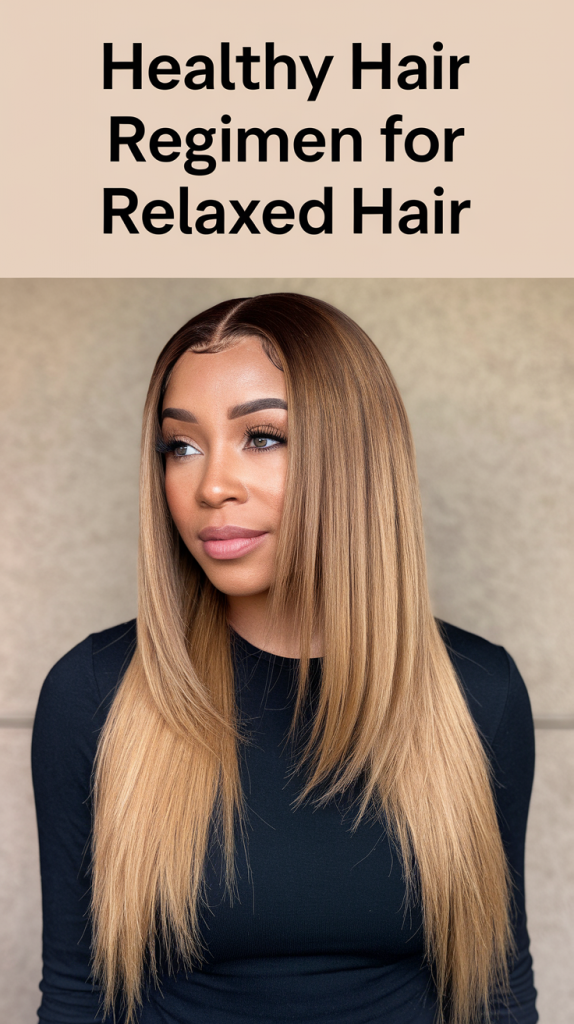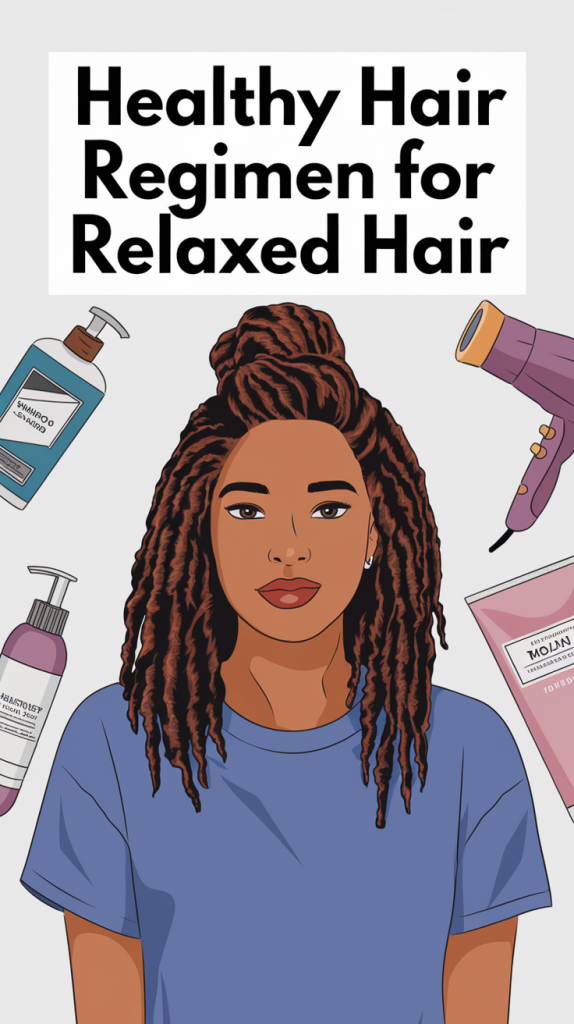Healthy Hair Regimen for Relaxed Hair
Understanding Relaxed Hair
Relaxed hair has undergone chemical treatments to alter its natural curl pattern. While this process achieves a smooth and manageable texture, it also compromises the hair’s natural strength and elasticity. The key to maintaining healthy relaxed hair lies in balancing moisture, protein, and gentle handling.

1. Cleansing
A clean scalp is the foundation of healthy hair growth, but over-cleansing can strip the hair of essential oils. Here’s how to cleanse effectively:
- Shampooing: Use a sulfate-free, moisturizing shampoo once a week to cleanse the scalp and hair without over-drying. Look for shampoos with nourishing ingredients like aloe vera, shea butter, or argan oil.
- Co-Washing: Midweek, consider co-washing (washing with conditioner) to refresh hair and retain moisture.
- Scalp Care: Incorporate a gentle scalp scrub or clarifying treatment once a month to remove buildup. Use oils with tea tree or peppermint to soothe irritation and promote circulation.
Quick Tip:
Massage your scalp during washing to boost blood flow and stimulate hair follicles.
Cleansing Frequency Table:
| Cleansing Type | Frequency | Key Benefits |
|---|---|---|
| Shampooing | Once a week | Removes dirt and buildup |
| Co-Washing | Midweek | Retains moisture, gentle refresh |
| Scalp Scrub | Monthly | Deep cleanses scalp, removes buildup |
2. Conditioning
Conditioning is non-negotiable for relaxed hair to maintain softness and prevent breakage.
- Deep Conditioning: After every wash, apply a deep conditioner enriched with proteins and natural oils. Use a hooded dryer or steamer to enhance penetration and leave it on for 15-30 minutes.
- Protein Treatments: Every 4-6 weeks, use a protein treatment to rebuild the hair’s structure. Be mindful not to overuse protein, as it can lead to brittleness.
- Leave-In Conditioners: Finish your wash routine with a lightweight leave-in conditioner to lock in moisture and add manageability.
Quick Tip:
Alternate between moisturizing and protein-rich deep conditioners to maintain balance.
Deep Conditioning Tips:
| Product Type | Frequency | Purpose |
| Moisturizing Conditioner | Weekly | Softens and hydrates |
| Protein Treatment | Every 4-6 weeks | Strengthens hair, prevents breakage |
| Leave-In Conditioner | After washing | Adds moisture and manageability |
3. Moisturizing and Sealing
Relaxed hair thrives when properly hydrated. This two-step method ensures moisture retention:
- Daily Moisturizing: Apply a water-based moisturizer every day or as needed. Products with water as the first ingredient are ideal.
- Sealing: Follow up with a natural oil, like coconut, olive, or argan oil, to lock in moisture and add shine.
Quick Tip:
Pay extra attention to the ends of your hair, as they are the oldest and most prone to damage.
4. Styling and Handling
Styling choices can make or break the health of your relaxed hair. Opt for techniques that reduce stress and heat exposure:
- Low-Heat Styling: Limit the use of flat irons and curling wands. When using heat, apply a heat protectant spray and keep the temperature moderate.
- Protective Styles: Styles like buns, braids, twists, or wigs protect your ends and reduce daily manipulation, promoting length retention.
- Handling: Detangle gently with a wide-tooth comb and avoid tight hairstyles that can lead to breakage.
Quick Tip:
Switch to satin or silk scrunchies to prevent friction and hair breakage.
5. Night Care
Night care is often overlooked but is crucial for retaining moisture and minimizing damage:
- Satin or Silk Scarves: Wrap your hair with a satin or silk scarf before bed to reduce friction.
- Satin Pillowcases: If scarves aren’t your thing, a satin pillowcase is an excellent alternative.
- Moisturizing Night Routine: Apply a light layer of moisturizer and sealant before bed to keep hair hydrated overnight.
Quick Tip:
Try a protective style like a loose braid or bun before sleeping to reduce tangling.

6. Nutrition and Lifestyle
Hair health starts from within. Nourish your body for stronger, healthier hair:
- Diet: Eat foods rich in biotin, zinc, iron, and omega-3 fatty acids. Eggs, nuts, leafy greens, and fish are excellent choices.
- Hydration: Drink plenty of water daily to keep your scalp and hair hydrated.
- Stress Management: High stress levels can cause hair thinning and breakage. Incorporate yoga, meditation, or regular exercise into your routine.
Quick Tip:
Consider taking hair supplements after consulting with a healthcare professional.
7. Seasonal Adjustments
Adapting your routine to seasonal changes can protect your hair:
- Winter: Use heavier oils and butters like shea butter to combat dryness.
- Summer: Opt for lighter products to prevent buildup in humid conditions. Protect hair from the sun with hats or UV-protective sprays.
Quick Tip:
Incorporate anti-humidity serums during the summer to maintain sleekness.
8. Regular Maintenance
Consistency is key to healthy relaxed hair. Follow these maintenance tips:
- Trimming: Trim your ends every 8-10 weeks to prevent split ends from traveling up the shaft.
- Relaxer Touch-Ups: Space relaxer applications every 8-12 weeks, applying the relaxer only to new growth to avoid over-processing.
Quick Tip:
Schedule trims and touch-ups with a professional stylist for the best results.

FAQs
- How often should I wash my relaxed hair? Wash relaxed hair once a week with a moisturizing shampoo and co-wash midweek if necessary.
- Can I use heat styling tools on relaxed hair? Minimize heat usage. When necessary, use a heat protectant and keep the temperature moderate.
- How do I prevent breakage in relaxed hair? Regular deep conditioning, protein treatments, and gentle handling are key to reducing breakage.
- What are protective styles, and why are they important? Protective styles like braids and twists shield the ends from damage and promote length retention.
- How can I address scalp dryness? Use oils with soothing ingredients like tea tree or peppermint and maintain hydration through diet and water intake.
- Is it necessary to trim relaxed hair regularly? Yes, trimming every 8-10 weeks prevents split ends and maintains overall hair health.
Conclusion
Healthy, relaxed hair is not only achievable but also sustainable with the right approach. By following a consistent routine that includes cleansing, conditioning, moisturizing, and protective styling, you can keep your hair strong, shiny, and resilient. Don’t forget the importance of nutrition, seasonal adjustments, and regular trims to maintain your progress. With patience and care, your relaxed hair can flourish. What steps will you incorporate into your routine today? Let me know in the comments!

